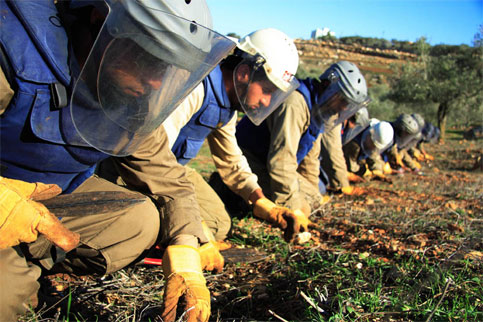Lebanon: Deminers find new cluster bomb sites without Israeli data
- Report: IRIN, UN humanitarian news and information service, 23 January 2008.

- Deminers from the Mine Action Group scour farmland in the village of
Zawtar West in south Lebanon for Israeli-dropped cluster bombs.
(Hugh Macleod/IRIN)
ZAWTAR WEST, 22 January: Deminers clearing Israeli-dropped cluster bombs in south Lebanon are turning up an average of 10 new sites per month, while Israel continues to ignore requests for data that would assist clearing the estimated one million unexploded bomblets, which continue to kill and maim civilians and decimate rural livelihoods. A single cluster bomb can disperse hundreds of bomblets.
“All these weapons systems are computerized and grid references are entered before the bombs drop. Not receiving the cluster bomb strike data from the Israelis remains our biggest obstacle to clearance,” Dalya Farran, a spokeswoman for the UN Mine Action Coordination Centre for South Lebanon (MACSL), told IRIN.
The UN estimates that Israel rained down around four million bomblets — most US-supplied — onto south Lebanon in the last three days of its 2006 July war with Hizballah fighters, when a ceasefire had already been agreed.
In a 24 December report last year the Israeli military cleared itself of accusations that it had violated international law in its use of cluster bombs to fight Hizballah. In a statement, the army said its chief investigator, Maj-Gen Gershon HaCohen, said: “It was clear that the majority of the cluster munitions were fired at open and uninhabited areas, areas from which Hizballah forces operated and in which no civilians were present.”
Around one million of the bomblets failed to explode on impact, leaving roads, schools, homes and fields littered with lethal explosives that detonate when touched, making them a danger similar to anti-personnel mines.
More strike sites
Initial estimates by MACSL that most of the unexploded munitions would be cleared by the end of last year have been revised to the end of this year.
Since the end of the war, over 30 Lebanese have been killed and over 200 injured, many permanently disabled from the loss of a limb after accidentally triggering an unexploded bomblet. The state provides no direct support for cluster bomb victims.
At the end of October 2006, two months after the end of the war, MACSL recorded 796 individual locations as infected with unexploded ordnance, totaling 32 million square meters of land.
By late last month that figure had risen to 961 strike locations, totaling 38 million square meters. According to MACSL, 137,000 bomblets have so far been safely destroyed, mainly in high priority areas, such as roads, homes and schools.
Farmers risk all
Tens of thousands of the bomblets still lie on farmland, however, making agriculture — the mainstay of the economy in south Lebanon on which 16,000 families depend — a dangerous and increasingly unprofitable pursuit.
A December 2006 report by the UN’s Food and Agriculture Organization (FAO) initially found around one quarter of all farmland had been infected, though the UN now estimates the figure is higher, and that nearly US$100 million in crops had been lost, along with 20,000 livestock.
At the Zawtar West site, 12 kilometers southwest of provincial capital Nabatiyeh, Lebanese deminers from Mine Action Group (MAG) painstakingly work their way through 70,000 square meters of farmland, cutting back precious olive trees in their search for bomblets.
Head of operations at Zawtar West Ghassan Suleiman said many farmers continue to plough their fields even knowing the land is littered with unexploded ordnance.
“Several farmers could not wait to plant their tobacco and vegetables and so took the risk and ploughed,” Suleiman told IRIN. “Many farmers and shepherds have been injured while sheep and many goats have been killed in the past two months, which represents a big loss for farmers.”
Tobacco crops have been hit particularly hard, with official figures reporting a 20 percent drop in the last harvest. Local farmers say their land has been so badly poisoned by the scorching of explosions that where 20 kilograms of tobacco plant would have grown, today yields on the same soil are just one kilogram.
Many farmers have been forced to abandon their land and lease non-infected land, adding a further heavy cost and reducing profits for some to less than US$1,000 for the year.
“Worst use”
Zawtar West reveals the extent of the Israeli cluster bomb bombardment, which locals say occurred on 13 and 14 August, the last two days of the war. In this single, small valley MAG deminers have turned up 15 separate strike sites, with each strike site representing up to 650 bomblets.
MACSL’s Farran compared the use of cluster bombs in south Lebanon with their use in Kosovo, an area comparable in size, in which NATO war planes dropped cluster bombs as part of a four-month bombing campaign in 1999 to drive out Serbian troops.
“In a two-and-a-half-year program, UNMAS [Mine Action Service] cleared 25,000 sub-munitions [in Kosovo] and that was 90 percent of the problem,” she said.
“In Lebanon, in a year and a half, we have cleared 137,000 bomblets, plus what have been cleared by the locals [representing just under 14 percent of the problem]. This was unprecedented and one of the worst, if not the worst, use of sub-munitions in history.”


